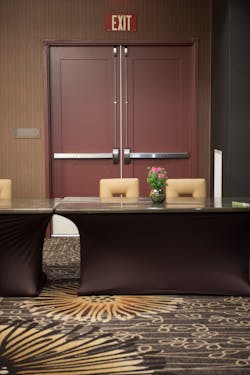The need for exit hardware that complies with local, state, and national fire codes is well known in construction. Locksmiths as well as door hardware companies provide quality exit hardware for schools, churches, retail businesses, industrial concerns, and many other kinds of facilities. This hardware also is commonly referred to as “panic hardware” and “fire exit hardware.” Take your pick.
Since the time that Von Duprin engineered the first exit hardware, there have been many milestones in the creation of modern egress devices that comply with a developing myriad of fire codes.
The following is several examples of literally hundreds: “…from the Iroquois Theater fire in Chicago in 1903 (602 deaths) to the 1942 Cocoanut Grove nightclub in Boston (492 deaths) to the Beverly Hills Supper Club fire in Southgate, Kentucky, in 1977 (165 deaths) to The Station nightclub fire in West Warwick, Rhode Island, in 2003 (100 deaths). The concentration of people in these occupancies, combined with a host of potential egress problems, have given many of these fires a tragic prominence in the country’s public safety history,” says Raymond J. Battalore, P.E., and Jack Sawyer, AIA, authors of Exit Strategy (http://bit.ly/2jsn88S).
Through each one of these and other tragedies, professions from all quarters have pulled their knowledge and knowhow to make facilities like these safer places to visit.
“That’s in part why egress—the ability to get out of a building safely and quickly—is such an elemental concept in both the renovation and new construction of assembly occupancies. It’s also why the egress schematic—or what NFPA 101®, Life Safety Code®, refers to as the “life safety floor plan”—is such an important tool for stakeholders in these projects,” says Battalore and Sawyer (http://bit.ly/2jsn88S).
It’s also why today’s fire exit hardware is so popular in both the new construction and retrofit areas.
Fire Code at the Point of Exit Discharge
In the event of fire, a code-compliant installation will prevent people from being trapped inside a burning building. The bottom line is that the locking or latching device must be easy to operate, intuitive, and require no special knowledge.
For example, Section 1008.1.9, taken from the IBC, entitled 'Door operations', "Except as specifically permitted by this section egress doors shall be readily openable from the egress side without the use of a key or special knowledge or effort" (Chapter 10, Means of Egress, 2010 Oregon Fire Code).
In Oregon fire code, in Section 1008.1.9.1, sets the stage for the use of the common, ordinary exit hardware that we, as locksmiths so often provide our clients. With a single motion, anyone must be able to immediately exit without delay, unless by special arrangement with the local AHJ (Authority Having Jurisdiction).
Section 1008.1.9.5, entitled ‘Unlatching,’ also stipulates that "The unlatching of any door or leaf shall not require more than one operation." Thus, fire exit hardware, whether it consists of a push bar that extends half way across the width of the egress door, or that of a push pad assembly (as per Section 7.2.1.7.1, Panic Hardware and Fire Exit Hardware, NFPA 101, Life Safety Code, 2009 Edition), none of them must require more than a single action to open the door and exit.
Exit Hardware Mounting
According to Section 7.2.1.7.1, NFPA 101, Life Safety Code, published by NFPA of Quincy, MA, “Where a door assembly is required to be equipped with panic or fire exit hardware, such hardware shall meet the following criteria:”
- Must be a cross bar or push pad that extends across the door by a minimum of 50 percent of its width.
- New installs requires a mounting height of 34 to 48 inches from floor level.
- Retrofit applications require a mounting height of 30 to 48 inches from floor level.
- The horizontal force applied to this egress device for activation must not exceed 15 lbf.
The mounting height cited above was adopted by the various code-making bodies, such as NFPA, IBC, and ANSI, in accordance with ADA (Americans With Disabilities Act) legislation. ADA was first introduced to the nation--including the life-safety community--in the early-to-mid 1990s.
There is an exclusion to this mounting height, however. Where another locking arrangement is employed, such as “Locks used only for security purposes and not for normal operation,” you can mount them at any height per Section 1008.1.9.2, IBC. This exclusion centers on an egress lock that is self-latching, which is not the same thing as self-locking. For example, devices often used on doors and gates that protect swimming pools, spas, and hot tubs can be installed at a maximum height of 54 inches above ground or that of the finished floor.
Another consideration cited earlier is that of the minimum force required for an exit hardware device to release a fire door. Chapter 10 of IBC, 2006 Edition, provides additional information on exit hardware and the application of force.
As adopted by New Jersey, under Section 1008.1.2, "The opening force for interior side-swinging doors without closers shall not exceed a 5-lb (22N) force. For other side swinging, sliding and folding doors, the door latch shall release when subjected to a 15-lb (67 N) force. The door shall be set in motion when subjected to a 15-pound (67 N) force. The door shall be set in motion when subjected to a 30-lb (133 N) force. The door shall swing to a full-open position when subjected to a 15-pound (67 N) force. Forces shall be applied to the latch side."
Panic Hardware and Fire Exit Hardware, NFPA 101, Life Safety Code, published by the National Fire Protection Association (NFPA) of Quincy, Mass., specifies the use of an exit device consisting of a “cross bar or push pad” that extends half way across the door or more.
Retrofit Code Compliance
Perhaps one of the most common mistakes when installing a different exit hardware device than was originally on the door is not so much what a locksmith does as much as what he fails to do during the process. One of the most common mistakes is leaving unused holes unfilled and open. This act of omission is critical because it changes the fire repellent characteristics of the door, thus changing how long it can withstand a fire.
NFPA 80, Section 5.2.15.4, says that “When holes are left in a door or frame due to changes or removal of hardware or plant-ons, the holes shall be repaired by the following methods:
1. Install steel fasteners that completely fill the holes
2. Fill the screw or bolt holes with the same material as the door or frame
The most common method for dealing with this issue is to screw steel screws into the holes. Sometimes people will install a plate over top of the, but when you do, to assure the integrity of the inner cavity within the door, you should weld the plate to the door. As mentioned earlier, steel screws will do the job and it won’t usually look bad afterwards.
Be sure to leave all labels, door or lock, clear of any paint you may use when painting the door and/or exit hardware device. If your client is renovating their facility, pass this information on to them so they do not make that mistake. Fire code through NFPA 80 4.2.2 requires that “Labels shall be applied in locations that are readily visible and convenient for identification by the AHJ after installation of the assembly.”
Fire exit hardware represents a huge money-making opportunity, not only the initial installation of the device, but also where it comes to routine inspections and service calls. Pick a manufacturer’s brand and make it a point to understand all the add-ons so you can up-sell during the initial sales call or any time after.
For More Info
For more information on exit hardware and exit alarms, contact your local locksmith distributor or the following manufacturers:
Adams Rite: www.adamsrite.com
Alarm Lock: www.alarmlock.com
Arrow: www.arrowlock.com
Corbin Russwin: www.corbinrusswin.com
Detex Corp.: www.detex.com
DORMA: www.dorma.com
Dynalock: www.dynalock.com
Marks USA: www.marksusa.com
Sargent and Greenleaf: www.sargentandgreenleaf.com
Sargent: www.sargentlock.com
SDC: www.sdcsecurity.com
Stanley Security: www.stanleysecurity.com
Von Duprin: www.us.allegion.com






